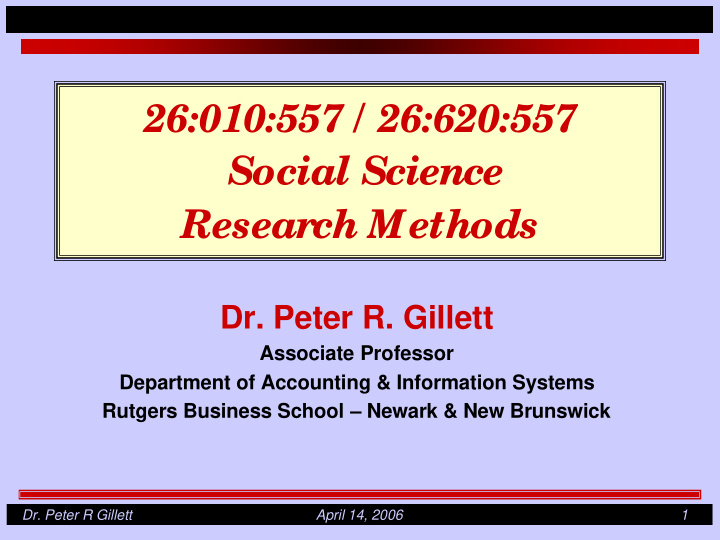



26:010:557 / 26:620:557 Social Science Research Methods Dr. Peter R. Gillett Associate Professor Department of Accounting & Information Systems Rutgers Business School – Newark & New Brunswick Dr. Peter R Gillett April 14, 2006 1
Overview I Organization Management and International Business Research I Naturalistic Inquiry Dr. Peter R Gillett April 14, 2006 2
Organization Management and International Business Research I Professor James Wade : Contemporary OM research � “Normative and Resource Flow Consequences of Local Regulations in the American Brewing Industry, 1845-1918” James B. Wade, Anand Swaminathan & Michael Scott Saxon Administrative Science Quarterly, 1998 � “Microlevel Opportunity Structures as Determinants of Non-CEO Executive Pay” Mason A. Carpenter & James B. Wade Academy of Management Journal, 2002 Dr. Peter R Gillett April 14, 2006 3
Organization Management and International Business Research I Professor Bill Newburry: Contemporary IB research � “A Cognitive Map of the International Business Field” Ramdas Chandra & William Newburry International Business Review, 1997 � “Ranking the International Business Journals” Frank L. DuBois & David Reeb Journal of International Business Studies, 2000 Dr. Peter R Gillett April 14, 2006 4
Naturalistic Inquiry I Qualitative research (K&L, pp. 588-593) � Field study � Uses direct observation and semistructured interviewing in real world settings � Looks for social transactions and interactions � Data collection is less structured � Method and hypotheses may be adjusted as the study proceeds � Naturalistic, participatory and interpretive � Design typically uses unobtrusive observer or participant observer Dr. Peter R Gillett April 14, 2006 5
Naturalistic Inquiry I Qualitative Research � Emanates from phenomenological perspective; emphasizes internal, mental events as the basic unit of existence � Knowledge is actively constructed and comes from examining the internal constructs of people � Investigator relies on outside observational schemes and tries to keep intact the participants’ perspective � Attempts to describe the ways that people assign meaning to behavior Dr. Peter R Gillett April 14, 2006 6
Naturalistic Inquiry I An alternative paradigm I Postpositivistic I Ethnographic I Phenomenological I Hermeneutic I Humanistic Dr. Peter R Gillett April 14, 2006 7
Naturalistic Inquiry I Prepositivist era � Aristotle - Hume I Positivist era � Hume � Mill � Comte � Logical positivists I Postpositivist era Dr. Peter R Gillett April 14, 2006 8
Naturalistic Inquiry I Mill’s Assumptions � Social and natural sciences have identical aims � Social and natural sciences are methodologically identical � Social sciences are merely more complex � Concepts can be defined by reference to empirical categories � Nature is uniform in time and space � Laws of nature can be inductively derived � Large samples suppress idiosyncracies and reveal general causes Dr. Peter R Gillett April 14, 2006 9
Naturalistic Inquiry I Mary Hesse � Standard account of scientific explanation N Naïve realism N Universal scientific language N Correspondence theory of truth Dr. Peter R Gillett April 14, 2006 10
Naturalistic Inquiry I Challenges to positivism � Leads to inadequate conceptualization of what science is � Unable to deal adequately with underdetermination of theory by data and theory-ladenness of facts � Overly dependent on operationalism � Leads to determinism and reductionism � Produces research that ignores humanness � Unable to deal with emergent conceptual/empirical formulations � Rests on five assumptions that are hard to maintain N Single tangible reality N Observer and observed can be separated N Temporal and contextual independence of observations N Linear causality N Axiological assumption of value freedom Dr. Peter R Gillett April 14, 2006 11
Naturalistic Inquiry I Axioms of naturalistic paradigm � Realities are multiple, constructed and holistic � Knower and known are interactive, inseparable � Only time- and context-bound working hypotheses (idiographic statements) are possible � All entities are in a state of mutual simultaneous shaping � Inquiry is value-bound Dr. Peter R Gillett April 14, 2006 12
Naturalistic Inquiry I Characteristics � Natural setting � Human instrument � Utilization of tacit knowledge � Qualitative methods � Purposive sampling � Inductive data analysis � Grounded theory � Emergent design � Negotiated outcomes � Case study reporting mode � Idiographic interpretation � Tentative application � Focus-determined boundaries � Special criteria for trustworthiness Dr. Peter R Gillett April 14, 2006 13
Naturalistic Inquiry I Basic beliefs of new paradigm � Complex � Heterarchic � Holographic � Indeterminate � Mutually casual � Morphogenetic � Perspectival Dr. Peter R Gillett April 14, 2006 14
Naturalistic Inquiry I Reality � Objective � Perceived � Constructed � Created Dr. Peter R Gillett April 14, 2006 15
Naturalistic Inquiry I Investigator-Object Dualism � Reactivity � Indeterminacy � Interaction Dr. Peter R Gillett April 14, 2006 16
Naturalistic Inquiry I Avoiding investigator bias � Member checks � Peer debriefings � Triangulation � Prolonged engagement & persistent observation � Reflexive journals � Independent audit Dr. Peter R Gillett April 14, 2006 17
Naturalistic Inquiry I Naturalistic Generalization I The Working Hypothesis I Nomothetic v. idiographic I Transferability and fittingness � Thick description I Holographic generalization Dr. Peter R Gillett April 14, 2006 18
Naturalistic Inquiry I Causality � Internal critique N Essentially, what we have discussed earlier � External critique N Doubts as to usefulness; rejection � Mutual simultaneous shaping N Explanation N Management N No directionality Dr. Peter R Gillett April 14, 2006 19
Recommend
More recommend